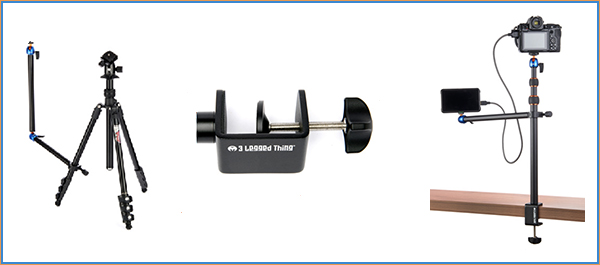Top Content Creator Tools from 3 Legged Thing, Nikon and SmallRig
Everyone is a Content Creator to one degree or another. Some earn their daily bread; others dribble out their daily dread. No matter where you fit on this spectrum, using top creator tools can help you up your game.

Nikon Z30 Creator’s Kit
Nikon makes it easy to assemble everything you need. At the heart is the popular Nikon Z30 camera with a Nikkor 16-50mm f/3.5-6.3 VR zoom lens. The Z30 has a 20.9-megapixel APS-C format sensor and can produce UHD 4K30p and Full HD 120p video, and it can live stream at 60p. It features a 3-inch Angle-Free touchscreen, tally lamp and dedicated selfie controls. Included in the kit with the Nikon Z30 is a Nikon ML-L7 Bluetooth remote control, Rode VideoMicro II microphone and a SmallRig tripod grip.

The Nikon Z30 Creator’s Kit is currently $746 at B&H (this may be a temporary promotional price). Alternatively, this Nikon Z30 bundle is sometimes available from Amazon. Visit the Official Nikon Store on amazon.com for more Nikon deals.

SmallRig All-in-One Smartphone Video Kit
SmallRig has become a Big Name in camera accessories, especially when it comes to tools for content creators. Their portfolio includes multiple lighting options, camera rigs, tripods a tons more.

The SmallRig Smartphone Video Kit includes a smartphone cage, desktop tripod, power bank holder, dual side handles, adjustable LED light, enhanced cardioid microphone, microphone shock mount, cables for smartphone and required mounting hardware. All in all, you get an awful lot with this all-in-one at a very affordable price: just $169.95 directly from SmallRig. SmallRig also has an Official Store on amazon.com.

3 Legged Thing Camera Desk Mount System
From the 2-legged mad (but brilliant) scientists at 3 Legged Thing comes the CDMS (Camera Desk Mount System) that’s the perfect addition to any content creator’s production studio. It’s available in three flavors (we recommend the biggest, Kit 2A) and it’s hyper-useful whether you’re selling via online auctions or creating content for social media.

The CDMS Basic Kit includes a vertical pole (similar to a center column on a tripod) that clamps to a table or desk and features a small omni-directional ball head with a strong rotational lock. Use it to support cameras, lights, microphones, compact monitors and other items with a standard 1/4×20 inch thread. Load limit is 2.2 pounds (1kg). Price is $34.99.
Kit 1A expands utility. It includes everything from the CDMS Basic Kit and adds an auxiliary arm that can be attached to the main pole, or used on its own on a tripod leg or center column. It features a ball head at the end for attaching accessories or smaller cameras. Price is just $15 more than the Basic Kit, $49.99.
We recommend the full-blown Kit 2A that features an extra arm that connects to the auxiliary to create an articulated horizontal arm. Price is $59.99. Go with the big kit.
All three kits are available at 3leggedthing.com and from authorized camera retailers online and in stores. To find your nearest 3LT retailer, visit their website. Take a look at 3 Legged Thing’s complete line of tripods, L-brackets and other photo accessories at the Official 3 Legged Thing store on amazon.com.
Want to Become a Better Photographer?
Begin by taking more pictures. Carry a camera everywhere you go and shoot even when you’re 100% sure the picture won’t turn out. Review all of your images with a critical eye and share them with others – and that includes posting the best on our Photo of the Day Gallery. Subscribe to our newsletter (see sign-up form on our homepage) and bookmark Shutterbug as a Favorite on your browser so you can check back often. We’re in this for the same reason as you – we love photography, and we’re learning more about it every day.
—Jon Sienkiewicz
(As an Amazon Associate, Shutterbug earns from qualifying purchases linked in this story.)


















